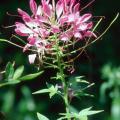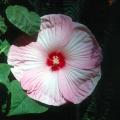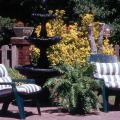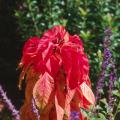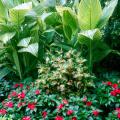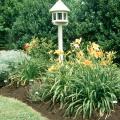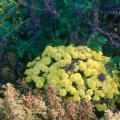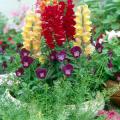Southern Gardening from 2001
By Norman Winter
MSU Horticulturist
Central Mississippi Research & Extension Center
As you drive down Mississippi's highways and by-ways, don't lament that we don't fare well with blue bonnets, because this year our own wild phlox, coreopsis, Queen Anne's lace and Indian Pinks have been as pretty as a painting.
By Norman Winter
MSU Horticulturist
Central Mississippi Research & Extension Center
The firebush, known as hummingbird bush and scarlet bush, is a Texas Superstar plant that would qualify in Mississippi as well. The Texas Superstar designation is similar to our Mississippi Medallion award.
By Norman Winter
MSU Horticulturist
Central Mississippi Research & Extension Center
Gardeners everywhere seem to be searching out vines for that special fence, trellis or arbor. The passionflower, one of my favorites, is not only one of the most beautiful and exotic blooms in the world, but the fruit also yields one of the favorite flavors in tropical fruit juices.
By Norman Winter
MSU Horticulturist
Central Mississippi Research & Extension Center
Many gardeners want plants that will bloom all summer right up until fall. The first option always seems to be New Gold lantana. Believe it or not, there is a tropical vine that will bloom until the first freeze as well. It is called Brazilian Jasmine, or Mandevilla.
By Norman Winter
MSU Horticulturist
Central Mississippi Research & Extension Center
Crape myrtles are starting to bloom all over the South, and it's not hard to see why they are the most popular summer flowering tree. Many gardeners mistakenly think they are native to this area, but Europeans discovered the Southeast Asia natives around 1750 and early settlers brought them to this country.
By Norman Winter
MSU Horticulturist
Central Mississippi Research & Extension Center
The future is looking bright for the cleome, one of the old time favorites in the Southern cottage garden. Unbelievably, there are new varieties of cleome poised to make their debut.
Cleome, sometimes called spider flower or spider plant, is native to several South American countries. Botanically speaking, it is known as Cleome hassleriana and is in the caper family. The capers we eat are known as Capparis.
By Norman Winter
MSU Horticulturist
Central Mississippi Research & Extension Center
One of the most striking vines for the southern landscape is about to get a new infusion of promotion thanks to the debut of two new varieties. Sunny Orange Wonder and Sunny Lemon Star are two new black-eyed Susan vines (Thunbergia alata) being introduced by BallFlora Plant that will hopefully be making their way to garden centers next spring.
By Norman Winter
MSU Horticulturist
Central Mississippi Research & Extension Center
When you look at a tropical hibiscus blooming on your deck or patio, it is easy to conjure up visions of the Caribbean and the sounds of a steel band. It's funny how plants can mentally take us where neither our budget nor time will allow. Can a perennial hibiscus do the same? You bet your bottom dollar!
By Norman Winter
MSU Horticulturist
Central Mississippi Research & Extension Center
No plant can impart the grace, elegance and lushness for the poolside or patio like a fern. While I love the perennial ferns that we grow with such ease in the garden, I also have a passion for the more tropical ferns.
By Norman Winter
MSU Horticulturist
Central Mississippi Research & Extension Center
If I were to list the things I love about Mississippi such as spring, fall, the people and my church, it would take up the whole column. But if you step outside this evening and listen, you will hear one of the most wonderful songs in nature, a nighttime melody coming from the green tree frogs. This is on my list of the things I love about Mississippi.
By Norman Winter
MSU Horticulturist
Central Mississippi Research & Extension Center
The old fashioned looks often catch the eyes of new gardeners. Such was the case at the Truck Crops Branch Experiment Station last October during the Fall Flower and Garden Fest. One of the plants that kept visitors gawking was the summer poinsettia.
By Norman Winter
MSU Horticulturist
Central Mississippi Research & Extension Center
While the hot muggy dog days of summer make you want to forget gardening and board an Alaskan cruise, it should signal you to get out and plant. The planting I refer to is sowing seeds of some great fall-blooming plants, namely zinnias and marigolds.
By Norman Winter
MSU Horticulturist
Central Mississippi Research & Extension Center
Never underestimate the power of foliage in the landscape. Mass plantings of coleus, cascading sweet potatoes and Joseph's Coats that provided an exciting contrast in color and leaf texture inspired me during recent trip to the Southern Nurserymen Convention in Atlanta.
By Norman Winter
MSU Horticulturist
Central Mississippi Research & Extension Center
Ornamental grasses are easy to grow, but there is a mystique that surrounds their use in the landscape. The mystery is all in the imagination of the gardener who has yet to try them.
By Norman Winter
MSU Horticulturist
Central Mississippi Research & Extension Center
If someone advertised free daylilies, would you go? Free daylilies may be waiting for you in the backyard already. Fall is just around the corner, and now is a good time to take a close look at your daylilies because they may have rewarded you with some free plants or "prolifs."
By Norman Winter
MSU Horticulturist
Central Mississippi Research & Extension Center
Copper is worth as much as gold in landscapes, especially now through fall. Some of the hottest commercial landscapes are using the copper plant and looking really good.
Southern gardeners have grown the copper plant for decades, but lately it has taken a backseat to the beautiful sun coleus. Despite my affection for the coleus, I do believe the copper plant has attributes that make it worthy of having around year after year.
By Norman Winter
MSU Horticulturist
Central Mississippi Research & Extension Center
This has been an awesome summer from the standpoint of temperature and moisture. Landscapes are looking great, and it is pleasant to get out and dig in the dirt. I'm sure my agronomy professor just rolled his eyes because we were taught never to call it dirt, but soil.
By Norman Winter
MSU Horticulturist
Central Mississippi Research & Extension Center
In the 18th century, the symbol of the pineapple was a welcome sign to visitors. Today, even if you don't do a lot of gardening, some well-placed colorful planters can welcome family and guests to your home. The gorgeous fall colors don't have to be limited to the yard or landscape, but can be artistically arranged as floral accents at your home's entrance.
By Norman Winter
MSU Horticulturist
Central Mississippi Research & Extension Center
In recent years, requests have gone out to gardeners and commercial landscapers to plant flowers in country colors for the Palaces of St. Petersburg, Splendors of Versailles and the Majesty of Spain exhibitions in Jackson. Recent national tragedies have inspired Americans to show their colors, and flowers can be part of the waving of the red, white and blue.
By Norman Winter
MSU Horticulturist
Central Mississippi Research & Extension Center
There are no doubt hundreds of us who see beautiful larkspurs each spring in gardens all over the South and wish we had them in our own gardens. The problem is timing.



